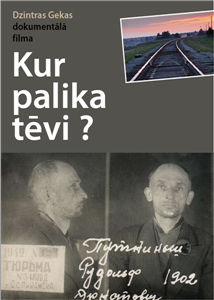Filmen textad på engelska. Beskrivning även p å engelska nedan.
å engelska nedan.
Lettiska regissören Dzintra Geka visar sin film "Vad hände med fäderna" på Lettiska Ambassaden den 29 augusti kl 17! Textad på engelska.
Organisatör Mellansvenska lettiska föreningen!
Kostnadsfritt inträde
Välkomna!
“Where Did the Fathers Go?”
A documentary film by Dzintra Geka
On June 14, 1941, the Soviet Union deported 15,425 people from Latvia (Latvians, Jews, Russians Poles) to Siberia. Among them were 3,751 children aged 16 or younger. During the process, men were separated from their families and brought to camps in the Soviet Gulag. Many were sentenced to death, while others found themselves in labour camps.
Many of the children who were deported to Siberia in 1941 never saw their fathers again. “The last time I saw my father was at the train station,” one of them recalls. “He was murdered at Vyatlag. I’m the only one left from my large family. I could forgive them on my own behalf, but never on behalf of my mother and my father. Putin was right when he said that it wasn’t an occupation. It was the most merciless form of murder.”
“My father was arrested and sent to the camp at Vyatlag, and he died there in March 1942,” says another former deportee. “He had never been convicted of a crime. They held a trial in the autumn of 1942, when he was already dead. A troika in Moscow sentenced him to ten years in prison with confiscation of property. The only reason was that our family was well-off. We had a large and wealthy farm with a windmill and livestock.”
Former prisoner Jēkabs Graudiņš: “Vyatlag was one of the most horrible concentration camps in the Russian Gulag. They took away our money, watches and rings. We knew that we would never see our wives and children again. Skujenieks from the Sesava Parish was the first to die. Some of the others lost their minds. More and more men started to die one after another.”
A trolley trundles down the overgrown railroad. For seventy years, the twelve participants in this group have thought about visiting the places from which their fathers never returned. The harsh environment, tension on people’s faces, collages of photographs, and brief moments of memories. At the centre of this documentary are trips to camps in Solyikamsk and Vyatlag.
Some fathers were sent to Solyikamsk in 1941 and put to work in salt mines and the forest. Historians believe that there were between 750 and 800 Latvians in Usolylag in the summer of 1941.
Fathers from Latvian families mostly died of enteritis, enterocolitis, meningitis, pneumonia, pleurisy, tuberculosis, strokes, nephritis, pellagra or dystrophy, or at least that is what their death certificates claimed. The truth is that most of the men perished because of the inhumane conditions under which they were being kept, suffering not only from diseases, but also from terrible cold and famine.
2,375 people from Latvia are buried at 22 concentration camp cemeteries in Vyatlag.
Director: Dzintra Geka
Screenplay: Ēriks Lanss
Camera: Aivars Lubānietis
Editor: Armands Zvirbulis
Music: Pēteris Vasks, Juris Karlsons
Video engineer: Jānis Kazulis
Assistant to the director: Baiba Ārenta
© Studija SB
72 min.